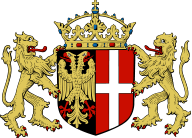 Neuss
NeussHistorisch
Kehl Tower
The Kehl Tower, built in the early 14th century together with the outer wall ring is the last surviving circular tower of the medieval town fortifications. Its name is derived from the ‘Kehl’ or ‘Kalle’, a branch of the Rhine that originates from the river’s course change from the 12th century onwards. Coming from the direction of Hamm, it met here with the old river course, fed from the Obererft and known as Erft river or Erft canal. With its mighty 2-metre-thick walls and its 12-metre diameter, the tower was a strong bulwark. Later the massive tower was equipped with artillery pieces. At the outer town wall, it serves as a bastion to protect the mooring site below and the Kehl.
In the early 19th century, the tower passed into the possession of the neighbouring monastery of the Alexian Brothers on Brückstrasse. Following the area’s destruction in World War Two, only the upper section of the buried Kehl Tower was uncovered again. In conjunction with the new Romaneum building and the uncovering of part of the town walls, it was restored in 2017 and opened to the public as part of guided tours. It houses a reconstruction of a medieval torture chair as well as the installations “Aleppo” and “Guantanamo” by the Neuss artist Wilfried Werbitzky.
Sources and texts: Neuss municipal archives
